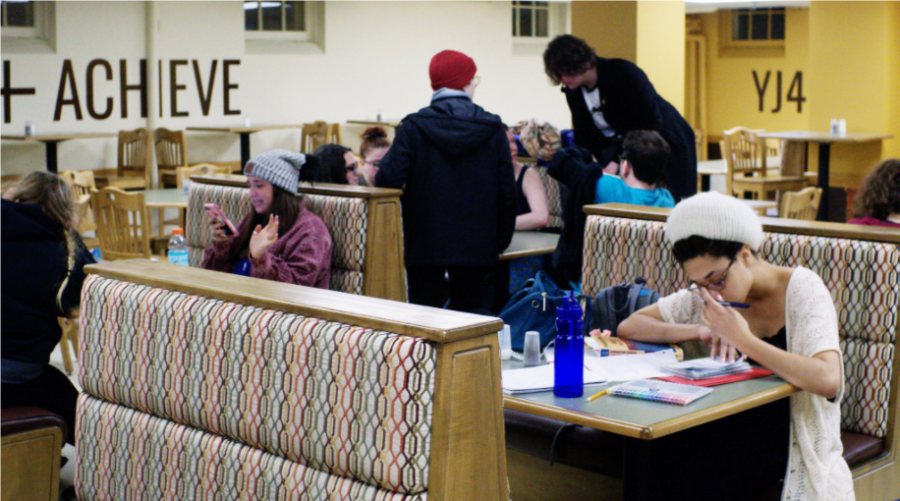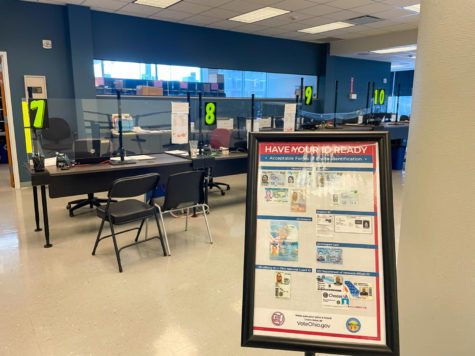New meal plan details announced
Options include set number of meals per week plus ‘flex’ dollars for use in bookstore, off-campus
Joey Geither
Under the new meal plans, students will receive a set number of meals per week for on campus dining locations, plus flex dollars to use off campus and at the bookstore.
After nearly two years of development, Baldwin Wallace has finally unveiled its refurbished meal plan structures for students, scheduled to take effect Fall 2018.
The plans are a deviation from the current Jacket Express system, where resident students will be able to choose from three separate plans – Prime, Choice, and Basic – as well as a fourth plan catered toward commuter students.
According to Dave Jensen, director of auxiliary services, these plans mimic those currently in use at other institutions, but are greatly discounted by hundreds of dollars when compared with sister programs.
The three plans are differentiated by the number of meals allotted per week with each meal carrying “an ‘equivalency’ or ala carte value of $7.50,” said Jensen.
The Prime plan consists of 21 meals per week, costing $2,882 per semester.
The Choice plan consists of 14 meals per week, costing $2,550 per semester.
The Basic plan consists of 10 meals per week, costing $2,250 per semester.
Each of the three plans for resident students includes $750 “flex dollars” that can be used at on- and off-campus dining, as well as tickets, printing, books and items from the Bookstore.
The Commuter plan, which is specifically geared toward students who do not live on campus and may only eat certain meals on campus, includes 25 meals total per semester and costs $185. The Commuter Plan does not have a mandatory flex dollar amount but works similar to the current Jacket Express system for commuters, where students can put down as much money as they desire.
Each of these Plans comes with a limited number of guest passes that will allow resident students to give dining hall access to visitors or others throughout the semester.
The new plans feature fewer aspects that “roll over” than the previous meal plans, both per week and per semester.
At the end of each semester, the only portion of each plan that can carry over to the next semester are Flex Dollars.
Additionally, the allotted meals per week do not extend to the following week; i.e., only consuming 20 meals one week will not result in a net total of 22 meals available in the following week. Guest passes are limited per semester as well.
One new aspect that Jensen mentioned, which arose as a result of student feedback, is the ability for resident students in at least their third-year to petition for the Commuter Meal Plan, so long as they can produce demonstrated – or documented – minimal use of their Jacket Express account in order to meet the cost of tuition.
Students will still be able to use their meal plan at places like Buzzy’s, the Cyber Cafe, LB’s Cafe, the smoothie stand at the Rec Center, the Starbucks that will be opening up in the new residence hall on Front street next to the Conservatory, Boca Loca, and Domino’s Pizza.
For the on-campus locations outside of dining halls, there will be a $7.50 Meal Equivalency limit – after that amount is reached and surpassed, students will have to pay the difference, either through flex or another meal swipe.
Jensen also said that the carry-out system will still be allowed under the new meal plan system, again citing student input. The difference with this carry-out system, Jensen said, is that students will have to purchase a carry-out container instead of purchasing the individual items for carryout, like in the Jacket Express system.
“They can choose to buy a sustainable product to trade out with us,” Jensen said. “It costs more, but in the end is actually more cost effective.”
Though the details were just made available, the overhaul of the meal plans was not new – it has been in the works for the past two years.
According to Jensen, the motivation to make these changes include the university’s financial sustainability and an increased effort to manage students’ financial control.
Under the old meal plans, much of the money that went unused in meal plans was returned to the students.
However, those funds are being directed back into campus improvements, he said.
“We need [that meal plan money] to pay for the dining plan, the bookstore operations, and… to assist in paying for our capital projects,” Jensen said. “[In the current meal plan], all of the money we are giving back are no longer going to any of our capital projects.”
Capital projects currently underway include a new Math and Computer Sciences Building, a new student union, renovations of Strosacker and the new housing and commercial center on Front Street next to the Conservatory.
In regards to students’ financial control and management, Jensen said that since Jacket Express can be used freely for things beyond meals “between 400-500 students, each year, are running out of money” for meals before the end of the semester.
As an example, he said, by October – three months into the semester – one student had already used up all of the money in their Jacket Express account.
As the meal plan information first reached the student body, it was met with criticism and inquiry, Jensen said.
“Initially, there was a lot of concern,” Jensen said. “A lot of it was that [parents and students] didn’t understand what was really happening. There was a lot of misconceptions.”
Kevin Kaufhold, current Student Body President, said that his first meetings in office actually consisted of the implantation of the new meal plans.
According to Kaufhold, the first meetings consisted of student organization leaders from various organizations around campus and BW administration, offering feedback on the meal plan outline at the time, and suggestions for improvement.
“Although it doesn’t seem like it from the normal student-body perspective, [the administration] definitely have bent a lot in our favor as students,” Kaufhold said.
For example, the first meetings between the administration and Student Senate adjusted the placement of the checkers which would charge meal plan accounts in the dining halls—particularly the Union.
Originally, the plans were to have the checkers positioned at the entrance of the dining hall, but it was suggested that this would burden students not eating at that time or students that did not have an active meal plan such as
Commuter students or upper-class resident students that petitioned for the Commuter Meal Plan.
“Because of that discussion with the students… we had to move the swipe entrance into the dining hall to where the registers are,” Jensen said.
Another primary concern for students was the amount of meals that they would be charged for simply going back and forth, only consuming certain items. This prompted the administration to implement hours of operation.
“[Students] can come and go without losing another swipe within that time frame,” Jensen said.
Recently, the Administration and Student Senate held an open forum to discuss the impending changes and expressed concerns, but with little attendance.
“Only about 11 students showed up,” Jensen said.
When they had a chance to discuss the upcoming plans, the students’ concerns seemed to be lessened, Kaufhold said.
“By the time that everybody left, they seemed ok with it,” he said. “Of course, they weren’t totally happy, but [they accepted the changes].”
In regards to future developments and potential adjustments to the meal plans, Jensen said that the administration will continue to listen to students throughout the next few semesters and analyze the trends of the plans.
More information on the Meal Plans can be accessed on BW’s website.
The Exponent is looking for financial contributions to support our staff and our newsroom in producing high-quality, well-reported and accurate journalism. Thank you for taking the time to consider supporting our student journalists.














































